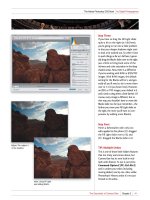The Adobe Photoshop CS5 Book for Digital Photographers part 10 docx
Bạn đang xem bản rút gọn của tài liệu. Xem và tải ngay bản đầy đủ của tài liệu tại đây (1.03 MB, 10 trang )
ptg
71Chapter 3Camera Raw—Beyond the Basics
The Adobe Photoshop CS5 Book for Digital Photographers
Before After
Download from www.wowebook.com
ptg
72
Chapter 3 Camera Raw—Beyond the Basics
The Adobe Photoshop CS5 Book for Digital Photographers
Step One:
Open a photo that has signs of chromatic
aberrations. If they’re going to appear,
they’re usually right along an edge in
the image that has lots of contrast (like
along the edges of these rock formations).
Press Z to get the Zoom tool and zoom
in on an area where you think (or see)
the fringe might be fairly obvious. Here,
there’s red fringe running along the edges
of the rocks. To remove this, start by click-
ing on the Lens Corrections icon (the
sixth icon from the left) at the top of
the Panel area.
Step Two:
In the Profile tab, turn on the Enable
Profile Corrections checkbox and Photo-
shop tries to remove the color fringe
based on your lens’ make and model (it
learns this from your image’s EXIF data.
See page 66 for more on this). If the
image still needs correction, try the C.
Aberration slider under Amount. If the
automatic way doesn’t work for you, try
getting rid of the fringe manually.
Chromatic aberration is a fancy name for that thin line of colored fringe
that sometimes appears around the edges of objects in photos. Sometimes
the fringe is red, sometimes green, sometimes purple, blue, etc., but all the
time it’s bad, so we might as well get rid of it. Luckily, Camera Raw has a
built-in fix that does a pretty good job.
Fixing Chromatic
Aberrations (That
Colored-Edge Fringe)
SCOTT KELBY
Download from www.wowebook.com
ptg
73Chapter 3Camera Raw—Beyond the Basics
The Adobe Photoshop CS5 Book for Digital Photographers
Step Three:
At the top of the Lens Corrections panel,
click on the Manual tab. Down in the
Chromatic Aberration section, there
are only two sliders and you just drag
toward the color you want to fix (they’re
labeled—the top one fixes red or cyan
fringe; the bottom fixes blue or yellow
fringe). But before you begin dragging
sliders, you may want to click on the
Detail icon (the third icon from the left
at the top of the Panel area) and lower
the Sharpening Amount to 0% (if you
added any or are fixing a RAW image),
because sharpening can also cause color
fringes to appear (and you want to make
sure you’re curing the right problem).
Step Four:
Start by moving the top Chromatic
Aber ration slider all the way to the
right (toward cyan), which reduces the
red fringe. Here, there’s still just a little
color fringe, so try choosing All Edges
from the Defringe pop-up menu, which
seems to do the trick.
TIP: Editing TIFFs and JPEGs
Although you can edit TIFFs and JPEGs
in Camera Raw, there is one “gotcha!”
Once you edit one of those in Camera
Raw, if you click the Done button (rather
than opening the image in Photoshop),
you’ll need to always open that photo
from within Camera Raw to see the edits
you made. That’s because those edits live
only inside of Camera Raw; if you bypass
Camera Raw and open an edited TIFF
or JPEG directly into Photoshop, the
Camera Raw edits you made earlier
won’t be visible.
Download from www.wowebook.com
ptg
74
Chapter 3 Camera Raw—Beyond the Basics
The Adobe Photoshop CS5 Book for Digital Photographers
Step One:
Here, you can see the dark areas in
the corners (that’s the bad vignetting).
This is normally caused by the camera’s
lens, so don’t blame yourself (unless you
bought a really cheap lens—then feel free
to give yourself as much grief as you can
bear). To remove this vignetting from
the corners, start by clicking on the Lens
Corrections icon (the sixth icon from the
left) at the top of the Panel area. In the
Profile tab, turn on the Enable Profile
Corrections checkbox and Photoshop
tries to remove the edge vignetting based
on your lens’ make and model (it learns
this from your image’s EXIF data. See
page 66 for more on this). If the image
still needs correcting, try the Vignetting
slider under Correction Amount.
Step Two:
If the automatic way just isn’t working, do
it manually by clicking on the Manual tab.
In the Lens Vignetting section, click on
the Amount slider and drag it to the right
until the vignetting in the corners disap-
pears. Once you move the Amount slider,
the Midpoint slider beneath it becomes
available and it determines how wide the
vignetting repair extends into your photo,
so drag it to the right to expand the
lightening farther toward the center
of your photo.
If you’re looking at a photo and the corners of the photo appear darker, that’s
lens vignetting. Generally, I look at it this way: If it’s just the corners, and they’re
just a little bit dark, that’s a problem and I fix it. However, sometimes I want
to focus the viewer’s attention on a particular area, so I create a vignette, but
I expand it significantly beyond the corners, so it looks like an intentional soft
spotlight effect. Here’s how to fix (or create) vignettes:
Edge Vignetting:
How to Fix It
and How to
Add It for Effect
SCOTT KELBY
Download from www.wowebook.com
ptg
75Chapter 3Camera Raw—Beyond the Basics
Continued
The Adobe Photoshop CS5 Book for Digital Photographers
Step Three:
Now for the opposite: adding vignetting
to focus attention (by the way, in the
“Special Effects for Photographers” chapter,
I also show you how to get the same
effect outside of Camera Raw). This time,
in the Lens Vignetting section you’re going
to drag the Amount slider to the left, and
as you drag left, you’ll start to see vignett-
ing appear in the corners of your photo.
But since it’s just in the corners, it looks
like the bad kind of vignetting, not the
good kind, so you’ll need to go on to the
next step.
Step Four:
To make the vignetting look more like
a soft spotlight falling on your subject,
drag the Midpoint slider quite a bit to
the left, which increases the size of the
vignetting and creates a soft, pleasing
effect that is very popular in portraiture,
or anywhere you want to draw attention
to your subject. That’s it—how to get rid
of ’em and how to add ’em. Two for the
price of one!
SCOTT KELBY
Download from www.wowebook.com
ptg
76
Chapter 3 Camera Raw—Beyond the Basics
The Adobe Photoshop CS5 Book for Digital Photographers
Step Five:
So far, adding the vignette has been
pretty easy—you just drag a couple of
sliders, right? But where you’ll run into
a problem is when you crop a photo,
because you’re also cropping the vignett-
ing effect away, as well (after all, it’s an
edge effect, and now the edges are in a
different place, and Camera Raw doesn’t
automatically redraw your vignette at the
newly cropped size). So, start by applying
a regular edge vignette (as shown here).
Step Six:
Now, let’s get the Crop tool (C) from
the toolbar, crop that photo in pretty
tight, and you can see what the problem
is—the vignette effect we just added is
pretty much gone (the dark edges were
cropped away).
Note: Adobe originally added the ability
to add a vignette after you’ve cropped an
image (called Post Crop Vignetting) back
in Photoshop CS4, but the problem was
when you added it, it didn’t look nearly
as good as the regular non-cropped
vignetting (even though it offered more
control, as seen at the bottom of the
Effects panel shown in Step Seven). It
kind of looked just like adding muddy
dark gray to the edges. Yeech!
SCOTT KELBY
Download from www.wowebook.com
ptg
77Chapter 3Camera Raw—Beyond the Basics
The Adobe Photoshop CS5 Book for Digital Photographers
Step Seven:
Let’s go add a post-crop vignette by clicking
on the Effects icon (the fourth icon from
the right) and, under Post Crop Vignetting,
dragging the Amount slider to the left to
darken the edges, then using the Midpoint
slider to choose how far into your image
this vignetting will extend (as seen here).
Now, here’s what they’ve added in CS5
(it makes all the difference in the world):
At the top of the Post Crop Vignetting
section is a pop-up menu with three
different types of vignetting: Highlight
Priority (which I think far and away looks
the best, and the most like the original
vignetting we applied back in Step Five),
which tries to maintain the highlight details
as the edges are darkened; Color Priority
tries to maintain the color while the edges
are darkened (it’s okay, but not great); and
Paint Overlay is the old method from CS4
that almost everybody hated (apparently
somebody liked it, because it’s still there).
I would stay away from this one altogether.
Step Eight:
Below the Midpoint slider is the Round-
ness slider that gives you control over the
roundness of the vignetting (lower the
Feather amount to 0, so you can get a
better idea of what the Roundness slider
does). The farther to the right you drag,
the rounder the shape gets, and when
you drag to the left, it actually becomes
more like a large, rounded-corner rect-
angle. The Feather slider determines
how soft that oval you created with the
Roundness slider becomes. I like it really
soft, so it looks more like a spotlight, so
I usually drag this slider quite a bit over
to the right (here I dragged it over to
73, but I wouldn’t hesitate to go higher,
depending on how it looks on the photo).
Download from www.wowebook.com
ptg
78
Chapter 3 Camera Raw—Beyond the Basics
The Adobe Photoshop CS5 Book for Digital Photographers
Step One:
There are three advantages to converting
your RAW files to Adobe DNG: (1) DNG
files are generally about 20% smaller.
(2) DNG files don’t need an XMP sidecar
file to store Camera Raw edits, metadata,
and keywords—the info’s embedded into
the DNG file, so you only have one file to
keep track of. And, (3) DNG is an open
format, so you’ll be able to open them in
the future (as I mentioned in the intro
above). If you have a RAW image open in
Camera Raw, you can save it as an Adobe
DNG by clicking the Save Image button
(as shown here) to bring up the Save
Options dialog (seen in the next step).
Note: There’s really no advantage to
saving TIFF or JPEG files as DNGs, so
I only convert RAW photos.
Adobe created DNG (an open archival format for RAW photos) because, at this point
in time, each camera manufacturer has its own proprietary RAW file format. If, one
day, one or more manufacturers abandon their proprietary format for something
new (like Kodak did with their Photo CD format), will we still be able to open our
RAW photos? With DNG, it’s not proprietary—Adobe made it an open archival
format, ensuring that your negatives can be opened in the future, but besides that,
DNG brings another couple of advantages, as well.
The Advantages of
Adobe’s DNG Format
for RAW Photos
SCOTT KELBY
Download from www.wowebook.com
ptg
79Chapter 3Camera Raw—Beyond the Basics
The Adobe Photoshop CS5 Book for Digital Photographers
Step Two:
When the Save Options dialog appears,
at the bottom of the dialog, from the
Format pop-up menu, choose Digital
Negative (shown here), click Save, and
you’ve got a DNG.
TIP: Setting Your DNG Preferences
Once you’ve converted to DNG, Camera
Raw does give you a few preferences
for working with these DNG files. Press
Command-K (PC: Ctrl-K) to bring up
Photoshop’s Preferences dialog, then click
on File Handling in the column on the
left side, and click on the Camera Raw
Preferences button (or press Command-K
when you have Camera Raw open). When
the dialog appears, go to the DNG File
Handling section (shown here). You’d
choose Ignore Sidecar “.xmp” Files only
if you use a different RAW processing
application (other than Camera Raw or
Lightroom), and you want Camera Raw
to ignore any XMP files created by that
application. If you turn on the Update
Embedded JPEG Previews checkbox (and
choose your preferred preview size from
the pop-up menu), then any changes you
make to the DNG will be applied to the
preview, as well.
Download from www.wowebook.com
ptg
80
Chapter 3 Camera Raw—Beyond the Basics
The Adobe Photoshop CS5 Book for Digital Photographers
Step One:
Here’s the original image of a red sculpture
on a washed-out, cloudy blue sky, and
what I’d like to do is tweak the color of
that sky so it’s a richer blue, which would
add a nice contrast to the red sculpture.
You tweak individual colors, or ranges of
color, in the HSL/Grayscale panel, so click
on its icon at the top of the Panel area (it’s
the fourth one from the left—circled here
in red). Now, click on the Luminance tab
(as shown here) to bring up the Luminance
controls (which control how bright the
colors appear).
Step Two:
The blue in the sky is washed out, so we
need to bring some richness and depth
back into the color, so drag the Blues slider
way over to the left toward the darker
blues (those color bars behind each slider
give you an idea of what will happen when
you drag a slider in a particular direction).
Now drag the Aquas sliders to the left
quite a bit, too (as shown here). Moving
the Aquas slider added a little more satu-
ration to the blue in the sky. How did
I know this was going to do that? I had
no idea. I just dragged each slider back
and forth real quick to see what it
would do. I know—it sounds awfully
simple, but it works.
In the next chapter, you’re going to learn how to paint an adjustment over
any part of your image, but sometimes you need to affect an entire area (like
you need the entire sky bluer, or the sand warmer, or a piece of clothing to be
an entirely different color). In those cases, where you’re adjusting large areas,
it’s usually quicker to use the HSL adjustments, which not only let you change
color, but also let you change the saturation and the lightness of the color.
It’s more powerful, and handy, than you might think.
Adjusting or
Changing Ranges
of Color
SCOTT KELBY
Download from www.wowebook.com









